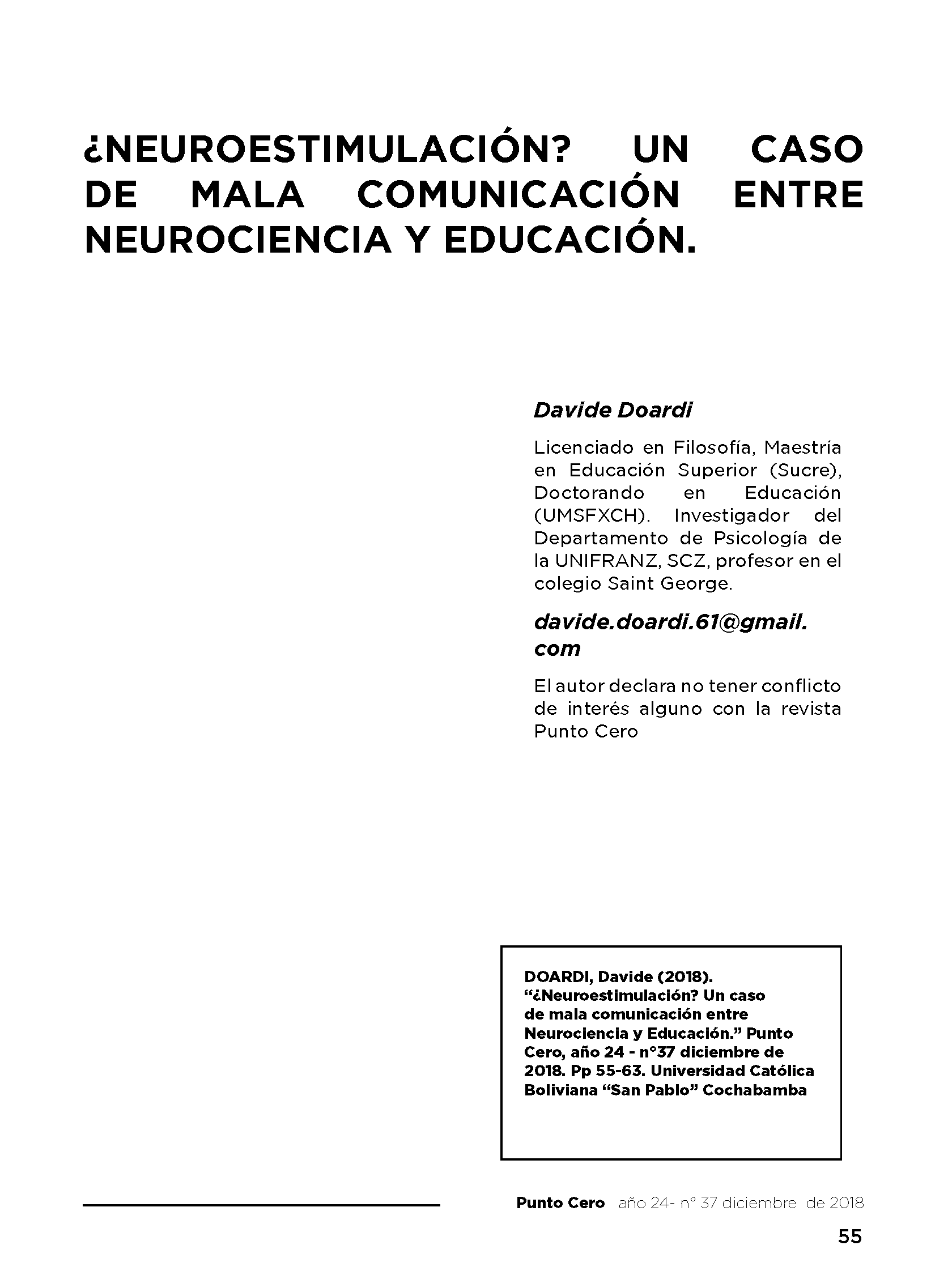Neurostimulation? An instance of miscommunication between Neuroscience and Education
DOI:
https://doi.org/10.35319/puntocero.20183742Keywords:
Emergentism, Neuroeducation, Pedagogy, TeachingAbstract
The matter with the current relation between Education and Neurosciences, is that it is asymmetrical: laypeople and scholars are inclined to see in the Neurosciences the scientific knowledge leading to direct applications in the educational domain. Aim of this article is to argue that this is not possible, not because of practical reasons but in principle. The epistemological and ontological framework is found in the Emergentism. The argument is supported by the analyses of two examples of failed marriage between education and neurosciences. As neuroeducation in the sense above mentioned is fundamentally a misunderstanding, it is advisable to modify practitioners’ expectations. The article suggests lines of investigation in accordance with the autonomy of Education and Neurosciences.
References
ÁGUILA, José Ramón Torres. (2005). El mito del período crítico para el aprendi- zaje de la pronunciación de un idioma ex- tranjero. Phonica, 1, 1-9
ANDERSON, O. Roger. (1992). Some inte- rrelationships between Constructivist Mo- dels of Learning and Current Neurobiolo- gical Theory, with implications for Science Education. Journal of Research in Science Teaching, 29(10), 1037-1058.
ANSARI, Daniel; DE SMEDT, Bert; GRAB- NER, Roland H. (2012), Neuroeducation–a critical overview of an emerging field. Neuroethics, 5(2), 105-117.
ANSARI, Daniel; KÖNIG, Johannes; LEASK, MARILYN, TOKUHAMA-ESPINO- SA, Tracey. (2017). Developmental Cog- nitive Neuroscience: Implications for tea- chers’ pedagogical knowledge, In Sonia GUERRIERO (Ed.), Pedagogical Knowle- dge and the Changing Nature of the Tea- ching Profession. Paris: OECD.
ANSARI, Daniel; COCH, Donna. (2006). Bridges over troubled waters: Education and cognitive neuroscience. Trends in cognitive sciences, 10(4), 146-151.
BOWERS, Jeffrey S. (2016). Psychology, not educational neuroscience, is the way forward for improving educational out- comes for all children: Reply to Gabrieli (2016) and Howard-Jones et al. (2016). Psychological Review, 123(5), 628-635.
BOWERS, Jeffrey S. (2016a). The prac- tical and principled problems with edu- cational neuroscience. Psychological Re- view, 123(5), 1-13.
BROAD, Charlie Dunbar. (1925). The Mind and Its Place in Nature. London: Routled- ge & Kegan.
BRUER, John T. (1997). Education and the Brain: A Bridge Too Far. Educational Re- searcher, 26(8), 4-16.
BRUER, John T. (2016). Where is Educa- tional Neuroscience? Educational Neuros- cience, 1, 1-12.
BUTTERWORTH, Brian; VARMA, Sashank; LAURILLARD, Diana. . (2011) Dyscalculia: from brain to education, Science, 332, 1049 – 1053.
CORTÉS MORENO, Maximiano (2001). El factor edad en el aprendizaje de una lengua extranjera, una revisión teórica. ADAXE – Revista de Estudios y Experien- cias Educativas, 17, 269-285.
DYSTEFL (2012). Dyslexia for teachers of English as a Foreign Language. Univer- sity of Lodz. Recuperado: http://dystefl.eu/index.php?id=20 Ultimo acceso: 4 No- viembre 2017
SLAVIN, Konstantin V.; ELJAMEL, Sam (2013). Neurostimulation: Principles and practice. Chichester, West Sussex: Wiley Blackwell.
FRITH, Utha; BISHOP, Dorothy; BLAKE- MORE, Colin; BLAKEMORE, Sara-Jane; BUTTERWORTH, Brian; GOSWANI, Usha. (2013). Neuroscience: implications for education and lifelong learning. Integrating Science and Practice, 3 (1), 6-10
GOSWANI, Usha. (2015). Neurociencia y Educación: ¿podemos ir de la investigación básica a su aplicación? Un posible marco de referencia desde la investigación en dislexia. Psicología Educativa, 21, 97–105.
HARDIMAN, Mariale; RINNE, Luke; GRE- GORY, Emma; YARMOLINSKAYA, Julia. (2012). Neuroethics, neuroeducation, and classroom teaching: Where the brain sciences meet pedagogy. Neuroethics, 5(2), 135-143.
HESS, Eckhard H. (1958). Imprinting in animals. Scientific American, 198(3), 81-90.
HESS, Walter Rudolf (1925). Über die Wechselbeziehungen zwischen psychischen und vegetativen Funktionen. Zürich: Orell Füssli.
HORVATH, Jared C.; DONOGHUE, Gregory M. A (2016). A bridge too far–re- visited: reframing Bruer’s neuroeducation argument for modern science of learning practitioners. Frontiers in psychology, 7, 1-12.
HOWARD-JONES, Paul A. (2014). Neuros- cience and education: myths and messages. Nature Reviews Neuroscience, 15(12), 817–824
HOWARD-JONES, Paul A.; VARMA, Sashank; ANSARI, Daniel; BUTTERWORTH, Brian; DE SMEDT, Bert; GOSWAMI, Usha; LAURILLARD, Diana; THOMAS, Michael (2016). The principles and practices of educational neuroscience: Comment on Bowers (2016). Psychological Review, 123(5), 620-627.
LALANCETTE, Hélène; CAMPBELL, Stephen R. (2012). Educational Neuroscience: Neuroethical Considerations. International journal of environmental and science education, 7(1), 37-52.
LENNEBERG, Eric H. (1967). Biological foundations of language. New York: John Wiley and Sons.
LORENZ, Konrad (1935). Der Kumpan in der Umwelt des Vogels. Der Artgenosse als auslösendes Moment sozialer Verha tensweisen. Journal für Ornithologie, 83, 137–215.
MENDOZA, Luis; CABALLERO, Solange; ORMEA, Verónica; AQUINO, Ruth; YAYA, Elena; PORTUGAL, Alan; GOMEZ, Jose; PORTUGAL, Alan; ZAVALETA, Juana; MUÑOZ, Ana. (2017). Neurociencia del sueño: rol en los procesos de aprendizaje y calidad de vida. Apuntes de Ciencia & Sociedad, 7(2), 103 –109.
NICOLSON, Roderick I.; FAWCETT, Angela J. . (2018). Procedural learning, dyslexia and delayed neural commitment. In Thomas LACHMANN .& Tina WEIS (Eds.), Reading and dyslexia. Springer: Cham. PARRINO, Liborio; VAUDANO, Anna Elisa- betta. (2017). The resilient brain and the guardians of sleep: new perspectives on old assumptions. Sleep Medicine Reviews, 30, 1-10.
SCHRAG, Francis. (2013). Can this marriage be saved? The future of ‘neuroeducation’. Journal of Philosophy of Education, 47(1), 20-30.
SCHWARTZ, Michael D.; KILDUFF, Thomas S. (2015). The neurobiology of sleep and wakefulness. The Psychiatric clinics of North America, 38(4), pp. 1-32.
SIEVERTSEN, Hans Henrik; GINO, Francesca; PIOVESAN, Marco. (2016). Cognitive fatigue influences students’ performance on standardized tests. Proceedings of the National Academy of Sciences, 113(10), 2621-2624.
TURNER, David A. (2012). Education and neuroscience. Contemporary Social Science: Journal of the Academy of Social Sciences, 7 (2), 167-179.
WEISBERG, Deena; KEIL, Frank; GOODS- TEIN, Joshua; RAWSON, Elisabeth; GRAY, Jeremy. (2008). The Seductive Allure of Neuroscience Explanations. Journal of Cognitive Neuroscience, 20, 470–477.
WEISBERG, Deena Skolnick; TAYLOR, Jordan CV; HOPKINS, Emily J. (2015). De- constructing the seductive allure of Neuroscience Explanations. Judgment and Decision Making, 10(5), 429-441.
ZADINA, Janet N . (2015). The emerging role of educational neuroscience in education reform. Psicología Educativa, 21(2), 71-77.

Downloads
Published
How to Cite
Issue
Section
License
Copyright (c) 2018 Revista Punto Cero

This work is licensed under a Creative Commons Attribution-NonCommercial 4.0 International License.








